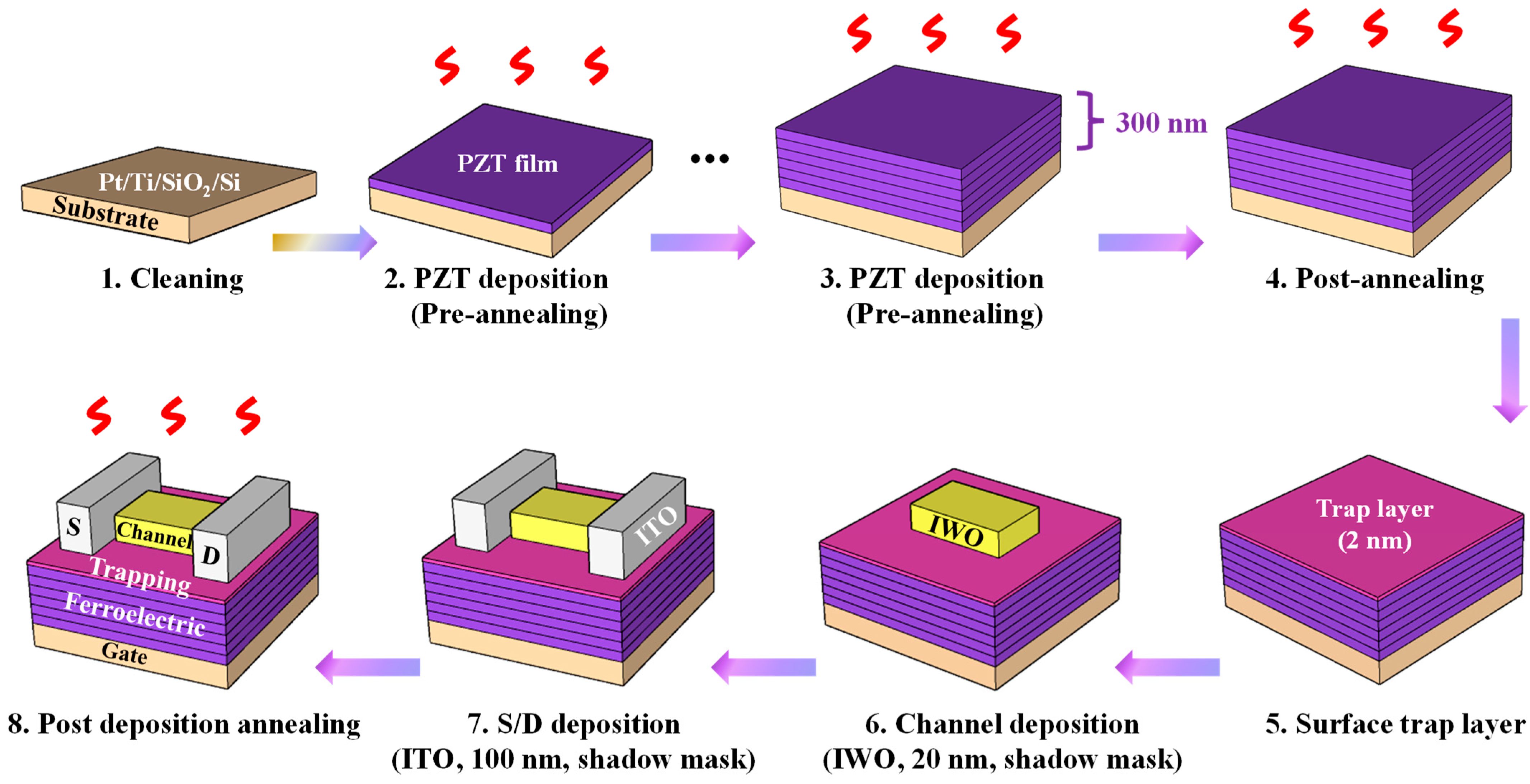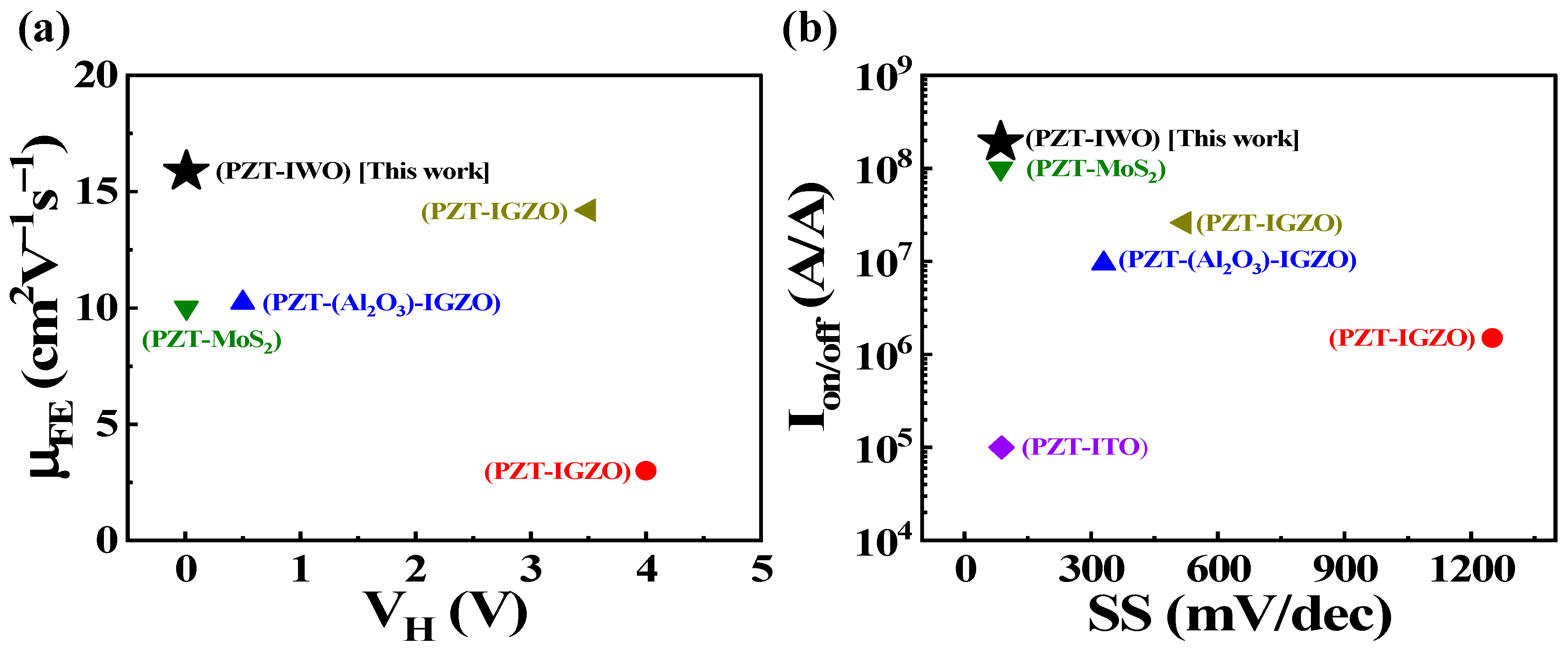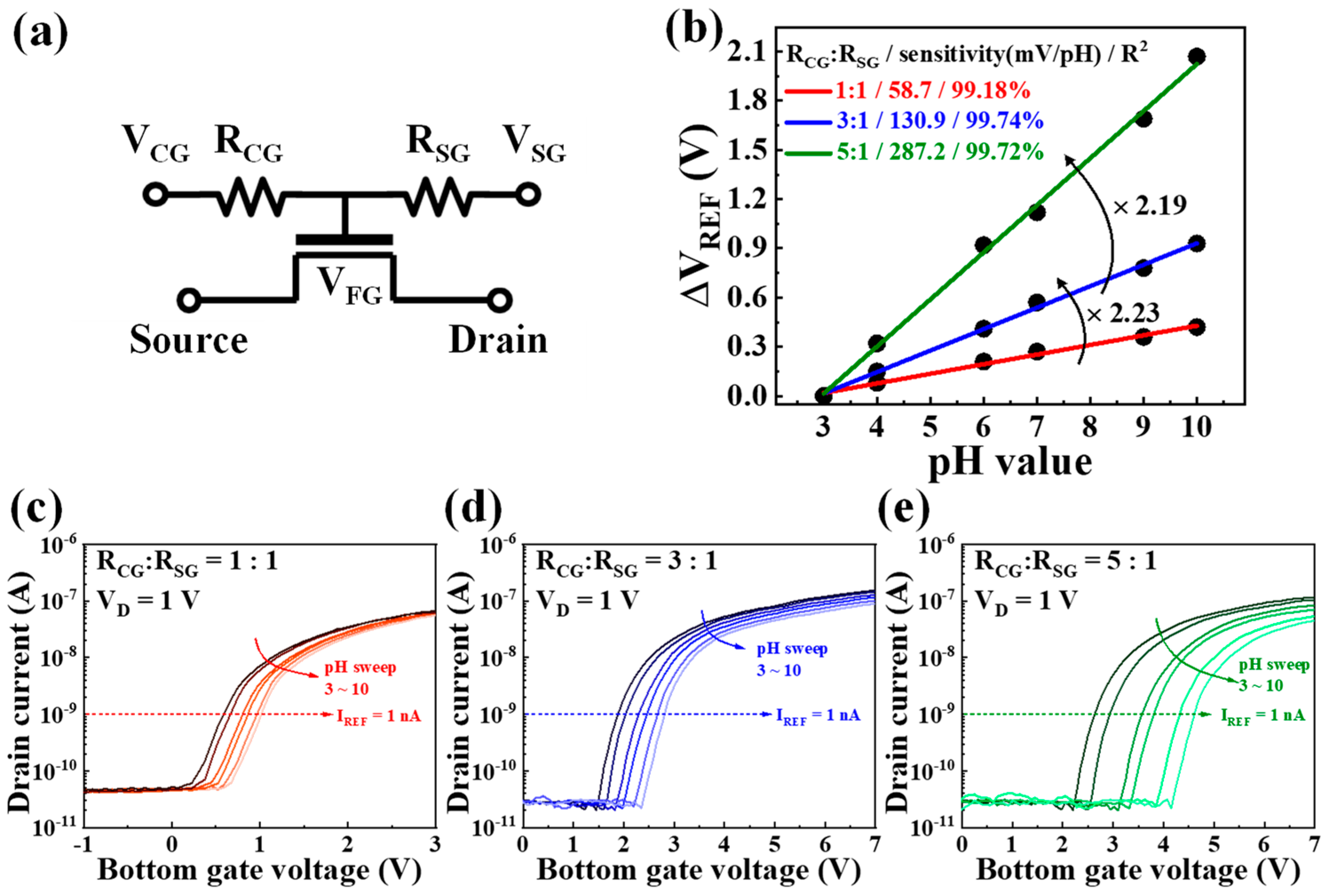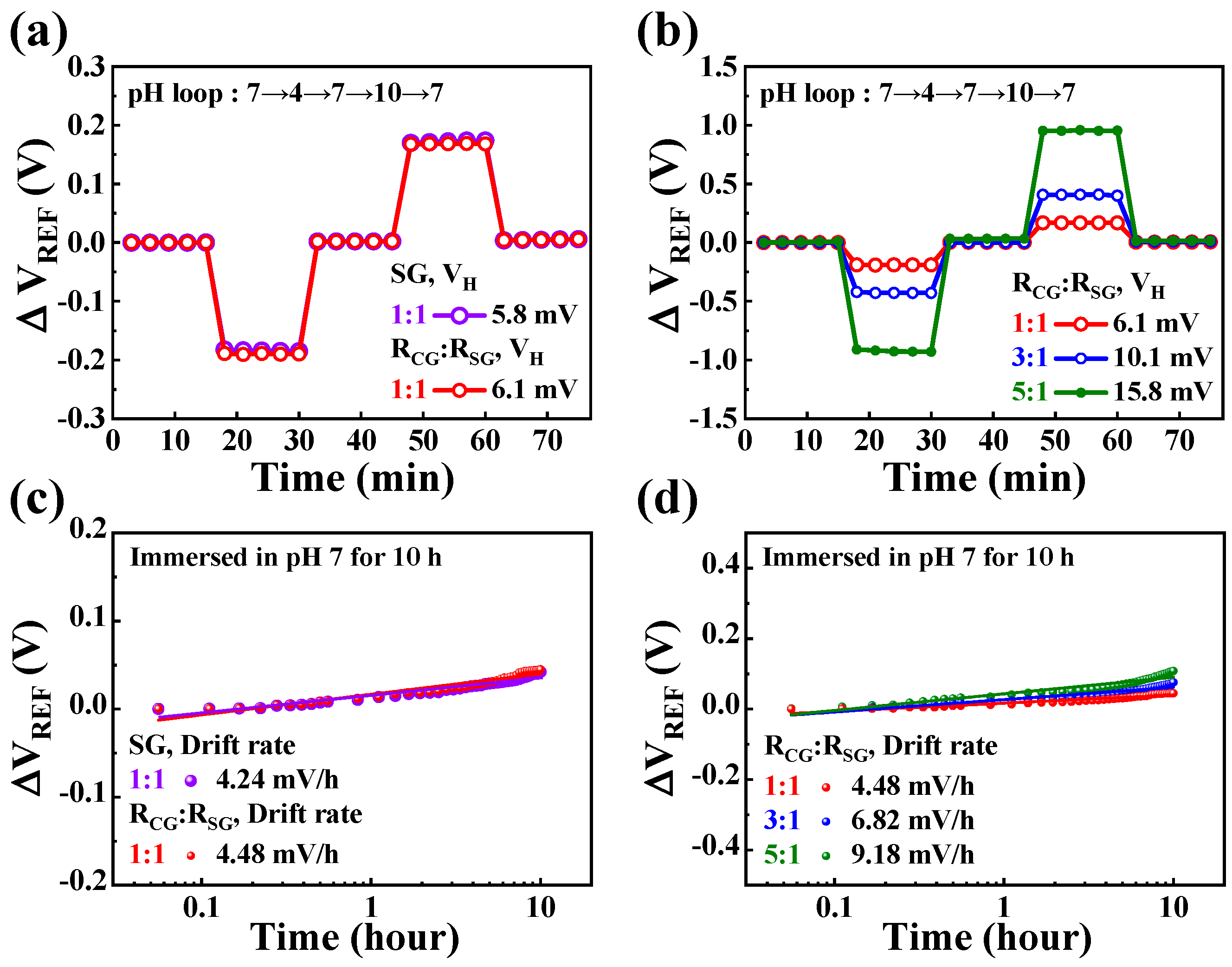Enhancement of Ion-Sensitive Field-Effect Transistors through Sol-Gel Processed Lead Zirconate Titanate Ferroelectric Film Integration and Coplanar Gate Sensing Paradigm
Abstract
:1. Introduction
2. Materials and Methods
2.1. Material Specifications
2.2. Formation of PZT Thin Film and Fabrication Process of FeFET
2.3. Fabrication of pH Selective EG Sensing Unit
2.4. Design of a Self-Resistive Coupling Circuit for Sensitivity Amplification
2.5. Device Characterization
3. Results and Discussion
3.1. Electrical Characteristics and Mechanism of PZT-FeFET
3.2. DC Bias Test for the Application of PZT-FeFET as Transducer
3.3. SG-Based EG-ISFET for pH Sensing
3.4. Sensitivity Amplification by Self-Resistive Coupling
3.5. Non-Ideal Effects of the Proposed Sensor Platform
4. Conclusions
Author Contributions
Funding
Institutional Review Board Statement
Informed Consent Statement
Data Availability Statement
Acknowledgments
Conflicts of Interest
References
- Capua, L.; Sprunger, Y.; Elettro, H.; Risch, F.; Grammoustianou, A.; Midahuen, R.; Ernst, T.; Barraud, S.; Gill, R.; Ionescu, A.M. Label-Free C-Reactive Protein Si Nanowire FET Sensor Arrays with Super-Nernstian Back-Gate Operation. IEEE Trans. Electron. Devices 2022, 69, 2159–2165. [Google Scholar] [CrossRef]
- Dolai, S.; Tabib-Azar, M. Zika virus field effect transistor. IEEE Sens. J. 2021, 21, 4122–4128. [Google Scholar] [CrossRef]
- Singh, A.K.; Pandey, A.; Chakrabarti, P. Fabrication, characterization, and application of CuO nano wires as electrode for ammonia sensing in aqueous environment using extended gate-FET. IEEE Sens. J. 2021, 21, 5779–5786. [Google Scholar] [CrossRef]
- Bausells, J.; Carrabina, J.; Errachid, A.; Merlos, A. Ion-sensitive field-effect transistors fabricated in a commercial CMOS technology. Sens. Actuators B 1999, 57, 56–62. [Google Scholar] [CrossRef]
- Olthuis, W.; Robben, M.A.M.; Bergveld, P.; Bos, M.; van der Linden, W.E. pH sensor properties of electrochemically grown iridium oxide. Sens. Actuators B 1990, 2, 247–256. [Google Scholar] [CrossRef]
- Moser, N.; Lande, T.S.; Toumazou, C.; Georgiou, P. ISFETs in CMOS and emergent trends in instrumentation: A review. IEEE Sens. J. 2016, 16, 6496–6514. [Google Scholar] [CrossRef]
- Huang, X.; Yu, H.; Liu, X.; Jiang, Y.; Yan, M.; Wu, D.; Dual-Mode, A. A Dual-Mode Large-arrayed CMOS ISFET sensor for accurate and high-throughput PH sensing in biomedical diagnosis. IEEE Trans. Biomed. Eng. 2015, 62, 2224–2233. [Google Scholar] [CrossRef]
- Pijanowska, D.G.; Torbicz, W. PH-ISFET based urea biosensor. Sens. Actuators B 1997, 44, 370–376. [Google Scholar] [CrossRef]
- Chodavarapu, V.P.; Titus, A.H.; Cartwright, A.N. CMOS ISFET microsystem for biomedical applications. In Proceedings of the 2005 IEEE International Reliability Physics Symposium, Irvine, CA, USA, 30 October 2005; IEEE Publications: Piscataway, NJ, USA, 2005; Volume 2005, p. 4. [Google Scholar]
- Rezaee, A.; Carrabina, J. Dual-gate organic thin-film transistor and multiplexer chips for the next generation of flexible EG-ISFET sensor chips. Sensors 2023, 23, 6577. [Google Scholar] [CrossRef]
- Pan, T.M.; Lin, L.A.; Ding, H.Y.; Her, J.L.; Pang, S.T. A simple and highly sensitive flexible sensor with extended-gate field-effect transistor for epinephrine detection utilizing InZnSnO sensing films. Talanta 2024, 275, 126178. [Google Scholar] [CrossRef]
- Chen, C.H.; Liu, S.B.; Chang, S.P. Performance Improvement of a ZnGa2O4 Extended-Gate Field-Effect Transistor pH Sensor. ACS Omega 2024, 9, 15304–15310. [Google Scholar] [CrossRef] [PubMed]
- Gubanova, O.; Poletaev, A.; Komarova, N.; Grudtsov, V.; Ryazantsev, D.; Shustinskiy, M.; Shibalov, M.; Kuznetsov, A. A novel extended gate ISFET design for biosensing application compatible with standard CMOS. Mater. Sci. Semicond. Process 2024, 177, 108387. [Google Scholar] [CrossRef]
- Harb, A.; Istanbullu, M. High sensitive PH sensor with graphene based dual-gate ISFET. J. Nano. Sci. Adv. Mater. 2023, 2, 19–24. [Google Scholar]
- Zain, A.S.M.; Dinar, A.M.; Salehuddin, F.; Hazura, H.; Hanim, A.R.; Idris, S.K.; Hamid, A.M.A. Beyond Nernst sensitivity of ion sensitive field effect transistor based on ultra-thin body box FDSOI. J. Phys. Conf. Ser. 2020, 1502, 012048. [Google Scholar] [CrossRef]
- Kim, Y.-U.; Cho, W.-J. Self-sensitivity amplifiable dual-gate ion-sensitive field-effect transistor based on a high-k engineered dielectric layer. Jpn. J. Appl. Phys. 2023, 62, SC1056. [Google Scholar] [CrossRef]
- Hyun, T.H.; Cho, W.J. High-performance FET-based dopamine-sensitive biosensor platform based on SOI substrate. Biosensors 2023, 13, 516. [Google Scholar] [CrossRef]
- Tan, G.; Kweon, S.H.; Kanno, I. Piezoelectric properties of epitaxial Pb(Zr Ti)O3 thin films grown on Si substrates by the sol–gel method. Thin Solid. Film. 2023, 764, 139612. [Google Scholar] [CrossRef]
- Zhang, Q.; Whatmore, R.W. Sol-gel PZT and Mn-doped PZT thin films for pyroelectric applications. J. Phys. D Appl. Phys. 2001, 34, 2296–2301. [Google Scholar] [CrossRef]
- Kweon, S.H.; Kanayama, Y.; Tan, G.; Koganezawa, T.; Kanno, I. In-situ study on piezoelectric responses of sol-gel derived epitaxial Pb[Zr,Ti]O3 thin films on Si substrate. J. Eur. Ceram. 2024, 44, 3887–3894. [Google Scholar] [CrossRef]
- Weng, L.; Bao, X.; Sagoe-Crentsil, K. Effect of acetylacetone on the preparation of PZT materials in sol-gel processing. Mater. Sci. Eng. B 2002, 96, 307–312. [Google Scholar] [CrossRef]
- Wu, Z.; Jie, W.; Yang, Z.; Hao, J. Hybrid heterostructures and devices based on two-dimensional layers and wide bandgap materials. Mater. Today Nano 2020, 12, 100092. [Google Scholar] [CrossRef]
- Pinto, R.M.R.; Gund, V.; Dias, R.A.; Nagaraja, K.K.; Vinayakumar, K.B. CMOS-integrated aluminum nitride MEMS: A review. J. Microelectromech. Syst. 2022, 31, 500–523. [Google Scholar] [CrossRef]
- Pintilie, I.; Pasuk, I.; Ibanescu, G.A.; Negrea, R.; Chirila, C.; Vasile, E.; Pintilie, L. The impact of the Pb(Zr,Ti)O3-ZnO interface quality on the hysteretic properties of a metal-ferroelectric-semiconductor structure. J. Appl. Phys. 2012, 112, 104103. [Google Scholar] [CrossRef]
- Damjanovic, D. Contributions to the piezoelectric effect in ferroelectric single crystals and ceramics. J. Am. Ceram. Soc. 2005, 88, 2663–2676. [Google Scholar] [CrossRef]
- Chen, H.M.; Lee, J.Y.M. Electron trapping process in ferroelectric lead–zirconate–titanate thin-film capacitors. Appl. Phys. Lett. 1998, 73, 309–311. [Google Scholar] [CrossRef]
- Afanasjev, V.P.; Petrov, A.A.; Pronin, I.P.; Tarakanov, E.A.; Kaptelov, E.J.; Graul, J. Polarization and self-polarization in thin PbZr1−xTixO3 (PZT) films. J. Phys. Condens. Matter. 2001, 13, 8755–8763. [Google Scholar] [CrossRef]
- Chen, J.; Dun, G.; Hu, J.; Lin, Z.; Wang, Y.; Lu, T.; Li, P.; Wei, T.; Zhu, J.; Wang, J.; et al. Polarized tunneling transistor for ultrafast memory. ACS Nano 2023, 17, 12374–12382. [Google Scholar] [CrossRef] [PubMed]
- Zhou, C.; Wang, X.; Raju, S.; Lin, Z.; Villaroman, D.; Huang, B.; Chan, H.L.W.; Chan, M.; Chai, Y. Low voltage and high ON/OFF ratio field-effect transistors based on CVD MoS2 and ultra high-k gate dielectric PZT. Nanoscale 2015, 7, 8695–8700. [Google Scholar] [CrossRef] [PubMed]
- Cho, S.K.; Cho, W.J. Ultra-high sensitivity pH-sensors using silicon nanowire channel dual-gate field-effect transistors fabricated by electrospun polyvinylpyrrolidone nanofibers pattern template transfer. Sens. Actuators B 2021, 326, 128835. [Google Scholar] [CrossRef]
- Parizi, K.B.; Xu, X.; Pal, A.; Hu, X.; Wong, H.S.P. ISFET pH sensitivity: Counter-ions play a key role. Sci. Rep. 2017, 7, 41305. [Google Scholar] [CrossRef]
- Garrido, J.A.; Härtl, A.; Kuch, S.; Stutzmann, M.; Williams, O.A.; Jackmann, R.B. pH sensors based on hydrogenated diamond surfaces. Appl. Phys. Lett. 2005, 86, 7. [Google Scholar] [CrossRef]
- Cho, S.K.; Cho, W.J. High-sensitivity pH sensor based on coplanar gate AlGaN/GaN metal-oxide-semiconductor high electron mobility transistor. Chemosensors 2021, 9, 42. [Google Scholar] [CrossRef]
- Chou, J.C.; Wang, Y.F. Preparation and study on the drift and hysteresis properties of the tin oxide gate ISFET by the sol-gel method. Sens. Actuators B 2002, 86, 58–62. [Google Scholar] [CrossRef]
- Hossain, S.; Rahman, M.T. Micro-heater embedded ISFET pH sensor with high-k gate dielectrics for enhanced sensitivity. Eng. Res. Express 2023, 5, 035068. [Google Scholar] [CrossRef]
- Xu, J.; Jiang, S.Y.; Zhang, M.; Zhu, H.; Chen, L.; Sun, Q.Q.; Zhang, D.W. Ferroelectric HfZrOx-based MoS2 negative capacitance transistor with ITO capping layers for steep-slope device application. Appl. Phys. Lett. 2018, 112, 103104. [Google Scholar] [CrossRef]
- Islam Sakib, F.; Hasan, M.A.; Mohona, M.D.; Hossain, M. Negative capacitance dual-gated ISFETs as ultra-sensitive pH sensors. ACS Omega 2023, 8, 48756–48763. [Google Scholar] [CrossRef]
- Xue, H.; Peng, Y.; Jing, Q.; Zhou, J.; Han, G.; Fu, W. Sensing with extended gate negative capacitance ferroelectric field-effect transistors. Chip 2024, 3, 100074. [Google Scholar] [CrossRef]
- Chi, L.L.; Chou, J.C.; Chung, W.Y.; Sun, T.P.; Hsiung, S.K. Study on extended gate field effect transistor with tin oxide sensing membrane. Mater. Chem. Phys. 2000, 63, 19–23. [Google Scholar] [CrossRef]
- Besleaga, C.; Radu, R.; Balescu, L.M.; Stancu, V.; Costas, A.; Dumitru, V.; Stan, G.; Pintilie, L. Ferroelectric field effect transistors based on PZT and IGZO. IEEE J. Electron. Devices Soc. 2019, 7, 268–275. [Google Scholar] [CrossRef]
- Jo, Y.; Lee, J.Y.; Park, E.; Kim, H.S.; Choi, H.J.; Mun, S.; Kim, Y.; Hur, S.; Yoon, J.H.; Jang, J.S.; et al. Epitaxial PZT film-based ferroelectric field-effect transistors for artificial synapse. ACS Appl. Electron. Mater. 2023, 5, 4549–4555. [Google Scholar] [CrossRef]
- Tue, P.T.; Miyasako, T.; Trinh, B.N.Q.; Li, J.; Tokumitsu, E.; Shimoda, T. Optimization of Pt and PZT films for ferroelectric-gate thin film transistors. Ferroelectrics 2010, 405, 281–291. [Google Scholar] [CrossRef]
- Teng, W.; Bao, S.Y.; Hu, Y.Q.; Deng, X.; Guan, Z.; Chen, B.B.; Zhong, N.; Xiang, P.H. Ferroelectric controlled interfacial effect on the electronic properties of PZT gated IGZO channel thin-film transistors. ACS Appl. Electron. Mater. 2024, 6, 1063–1070. [Google Scholar] [CrossRef]
- Bakker, E.; Pretsch, E.; Bühlmann, P. Selectivity of potentiometric ion sensors. Anal. Chem. 2000, 72, 1127–1133. [Google Scholar] [CrossRef]
- Tran, T.N.T.; Qiu, S.; Chung, H.-J. Potassium ion selective electrode using polyaniline and matrix-supported ion-selective PVC membrane. IEEE Sens. J. 2018, 18, 9081–9087. [Google Scholar] [CrossRef]
- Chen, X.-W.; Huang, S.-R.; Huang, N.-T. Dual Ion-Selective Membrane Deposited Ion-Sensitive Field-Effect Transistor Integrating a Whole Blood Processing Microchamber for In Situ Blood Ion Testing. ACS Sens. 2023, 8, 904–913. [Google Scholar] [CrossRef] [PubMed]
- van den Berg, A.; Grisel, A.; Verney-Norberg, E. An ISFET-based calcium sensor using a photopolymerized polysiloxane membrane. Sens. Actuators B 1991, 4, 235–238. [Google Scholar] [CrossRef]
- Chou, J.C.; Weng, C.Y. Sensitivity and hysteresis effect in Al2O3 gate pH-ISFET. Mater. Chem. Phys. 2001, 71, 120–124. [Google Scholar] [CrossRef]
- Jamasb, S.; Collins, S.; Smith, R.L. A physical model for drift in pH ISFETs. Sens. Actuators B 1998, 49, 146–155. [Google Scholar] [CrossRef]
- Chiang, J.L.; Jan, S.S.; Chou, J.C.; Chen, Y.C. Study on the temperature effect, hysteresis and drift of PH-ISFET devices based on amorphous tungsten oxide. Sens. Actuators B 2001, 76, 624–628. [Google Scholar] [CrossRef]
- Bousse, L.; Bergveld, P. The role of buried OH sites in the response mechanism of inorganic-gate pH-sensitive ISFETs. Sens. Actuators 1984, 6, 65–78. [Google Scholar] [CrossRef]







| Channel | VH (V) | Vth (V) | SS (mV/dec) | µFE (cm2V−1s−1) | Ion/off (A/A) | Ref. |
|---|---|---|---|---|---|---|
| IGZO | 4 | 1.2, 2.6 | 1250 | 1.5, 3 | 1.5 × 106 | [40] |
| IGZO | 0.5 | - | 330 | 10.23 | 9.5 × 106 | [41] |
| MoS2 | 0.01 | 0.2~0.4 | 85.9 | 10.01 | ~108 | [29] |
| ITO | 1.2 | - | 88 | - | 105 | [42] |
| IGZO | 3.5 | - | 520 | 14.2 | 5.6 × 107 | [43] |
| IWO | 0.01 | 0.8 | 85.75 | 15.87 | 1.91 × 108 | This work |
| Amplification Ratio (RCG/RSG) | Hysteresis Voltage (mV) | Drift Rate (mV/h) | Sensitivity (mV/pH) |
|---|---|---|---|
| ×1 (SG mode) | 5.8 | 4.24 | 57.2 |
| ×1 (RC mode) | 6.1 | 4.48 | 58.7 |
| ×3 (RC mode) | 10.1 | 6.82 | 130.9 |
| ×5 (RC mode) | 15.8 | 9.18 | 287.2 |
Disclaimer/Publisher’s Note: The statements, opinions and data contained in all publications are solely those of the individual author(s) and contributor(s) and not of MDPI and/or the editor(s). MDPI and/or the editor(s) disclaim responsibility for any injury to people or property resulting from any ideas, methods, instructions or products referred to in the content. |
© 2024 by the authors. Licensee MDPI, Basel, Switzerland. This article is an open access article distributed under the terms and conditions of the Creative Commons Attribution (CC BY) license (https://creativecommons.org/licenses/by/4.0/).
Share and Cite
Mah, D.-G.; Oh, S.-M.; Jung, J.; Cho, W.-J. Enhancement of Ion-Sensitive Field-Effect Transistors through Sol-Gel Processed Lead Zirconate Titanate Ferroelectric Film Integration and Coplanar Gate Sensing Paradigm. Chemosensors 2024, 12, 134. https://doi.org/10.3390/chemosensors12070134
Mah D-G, Oh S-M, Jung J, Cho W-J. Enhancement of Ion-Sensitive Field-Effect Transistors through Sol-Gel Processed Lead Zirconate Titanate Ferroelectric Film Integration and Coplanar Gate Sensing Paradigm. Chemosensors. 2024; 12(7):134. https://doi.org/10.3390/chemosensors12070134
Chicago/Turabian StyleMah, Dong-Gyun, Seong-Moo Oh, Jongwan Jung, and Won-Ju Cho. 2024. "Enhancement of Ion-Sensitive Field-Effect Transistors through Sol-Gel Processed Lead Zirconate Titanate Ferroelectric Film Integration and Coplanar Gate Sensing Paradigm" Chemosensors 12, no. 7: 134. https://doi.org/10.3390/chemosensors12070134





